Serving 410 students in grades 6-8, Marshall Middle School ranks in the bottom 50% of all schools in Virginia for overall test scores (math proficiency is bottom 50%, and reading proficiency is bottom 50%).
The percentage of students achieving proficiency in math is 48% (which is lower than the Virginia state average of 54%). The percentage of students achieving proficiency in reading/language arts is 69% (which is equal to the Virginia state average of 69%).
The student:teacher ratio of 10:1 is lower than the Virginia state level of 14:1.
Minority enrollment is 38% of the student body (majority Hispanic), which is lower than the Virginia state average of 56% (majority Black and Hispanic).
Quick Stats (2025)
- Grades: 6-8
- Enrollment: 410 students
- Student:Teacher Ratio: 10:1
- Minority Enrollment: 38%
- Overall Testing Rank: Bottom 50% in VA
- Math Proficiency: 48% (Btm 50%)
- Reading Proficiency: 69% (Top 50%)
- Science Proficiency: 55-59% (Top 50%)
- Source: National Center for Education Statistics (NCES), VA Dept. of Education
Top Rankings
Marshall Middle School ranks among the top 20% of public schools in Virginia for:
Category
Attribute
Student Attention
School Overview
Marshall Middle School's student population of 410 students has declined by 15% over five school years.
The teacher population of 43 teachers has declined by 6% over five school years.
Grades Offered
Grades 6-8
(offers virtual instruction)
(offers virtual instruction)
Total Students
410 students
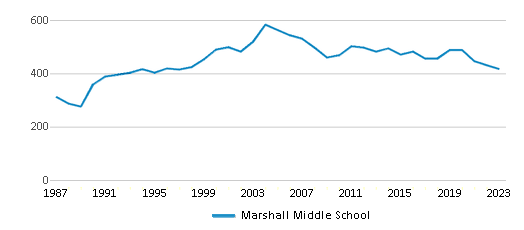
Gender %
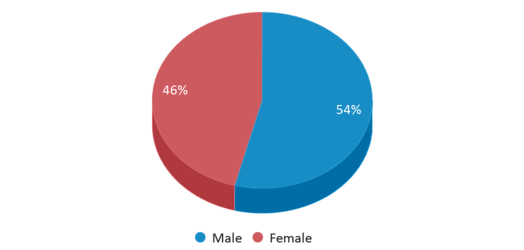
Total Classroom Teachers
43 teachers
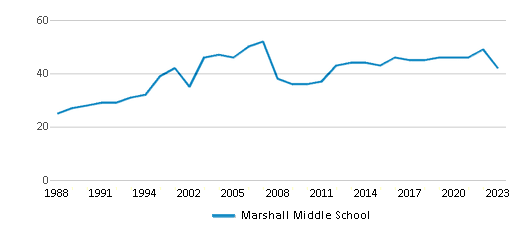
Students by Grade
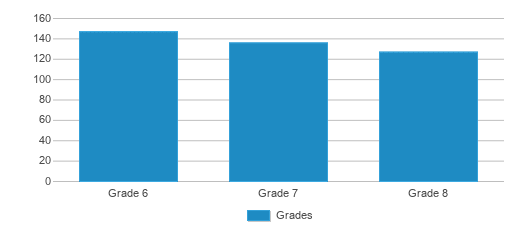
School Rankings
Marshall Middle School ranks within the bottom 50% of all 1,792 schools in Virginia (based off of combined math and reading proficiency testing data).
The diversity score of Marshall Middle School is 0.53, which is less than the diversity score at state average of 0.72. The school's diversity has stayed relatively flat over five school years.
Overall Testing Rank
#1020 out of 1792 schools
(Bottom 50%)
(Bottom 50%)
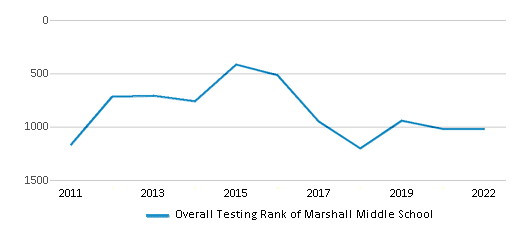
Math Test Scores (% Proficient)
(20-21)48%
54%
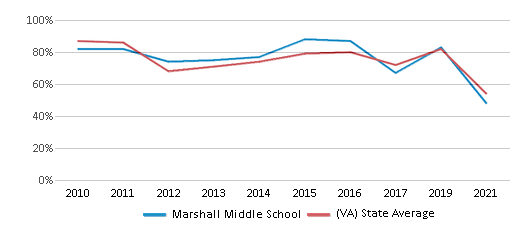
Reading/Language Arts Test Scores (% Proficient)
(20-21)69%
69%
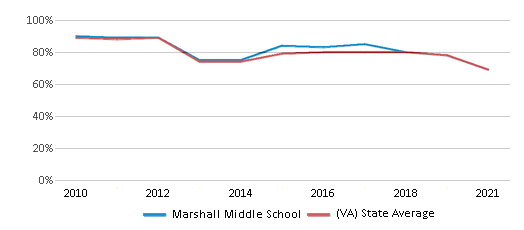
Science Test Scores (% Proficient)
(20-21)55-59%
59%
Student : Teacher Ratio
10:1
14:1

American Indian
n/a
n/a
Asian
n/a
8%
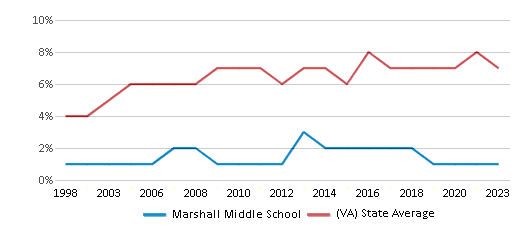
Hispanic
29%
19%
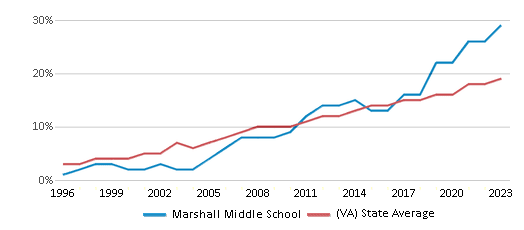
Black
3%
22%
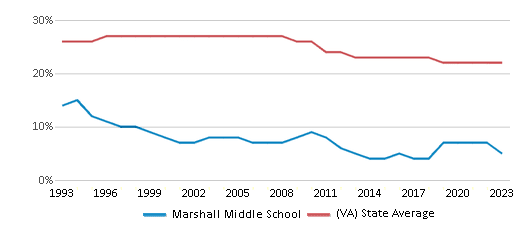
White
62%
44%
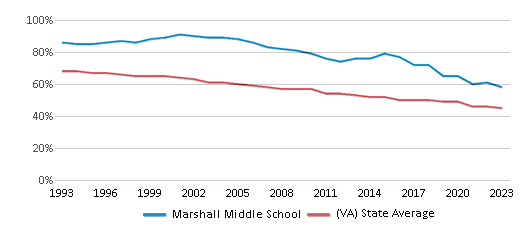
Hawaiian
n/a
n/a
Two or more races
6%
7%
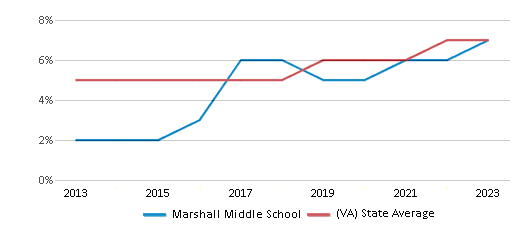
All Ethnic Groups
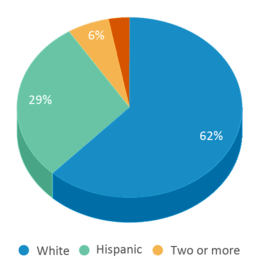
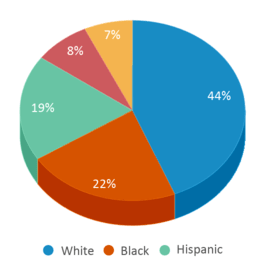
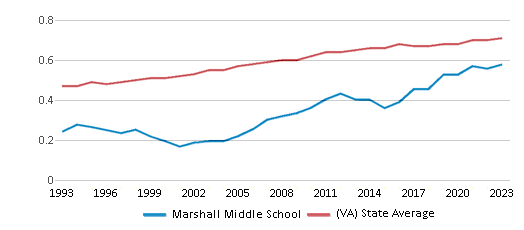
Eligible for Free Lunch
34%
55%
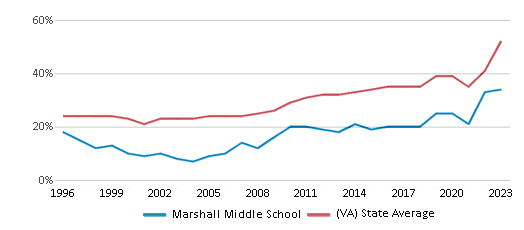
Eligible for Reduced Lunch
3%
2%
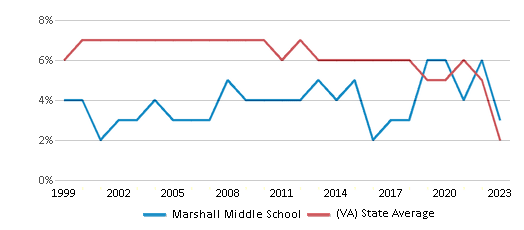
School Statewide Testing
School District Name
Source: National Center for Education Statistics (NCES), VA Dept. of Education
Profile last updated: 02/09/2025
Frequently Asked Questions
What is Marshall Middle School's ranking?
Marshall Middle School is ranked #1020 out of 1,792 schools, which ranks it among the bottom 50% of public schools in Virginia.
What schools are Marshall Middle School often compared to?
Marshall Middle Schoolis often viewed alongside schools like Auburn Middle School by visitors of our site.
What percent of students have achieved state testing proficiency in math and reading?
48% of students have achieved math proficiency (compared to the 54% VA state average), while 69% of students have achieved reading proficiency (compared to the 69% VA state average).
How many students attend Marshall Middle School?
410 students attend Marshall Middle School.
What is the racial composition of the student body?
62% of Marshall Middle School students are White, 29% of students are Hispanic, 6% of students are Two or more races, and 3% of students are Black.
What is the student:teacher ratio of Marshall Middle School?
Marshall Middle School has a student ration of 10:1, which is lower than the Virginia state average of 14:1.
What grades does Marshall Middle School offer ?
Marshall Middle School offers enrollment in grades 6-8 (offers virtual instruction).
What school district is Marshall Middle School part of?
Marshall Middle School is part of Fauquier County School District.
School Reviews
1 8/26/2019
This was once a fabulous school. However, when the administration changed over, I see a lot of unusual practices with the teachers and the administration. They are rude, do as they please, and do not follow the policy on many different subjects. Many of the teachers let their students know their political beliefs, discourage your child's political beliefs if they differ, and they are a way to open with their comments being public servants. You are there to teach our children..... not push your beliefs (political, religious, etc). That is not okay. They also punish the students by affecting their grades if for some reason they don't like your child. Which is wrong to even let a child know that you somehow for whatever reason dislike them?! School board should get involved with this school fast before a civil lawsuit is filled.
Review Marshall Middle School. Reviews should be a few sentences in length. Please include any comments on:
- Quality of academic programs, teachers, and facilities
- Availability of music, art, sports and other extracurricular activities
Recent Articles

What Is A Charter School?
Explore the world of charter schools in this comprehensive guide. Learn about their history, how they operate, and the pros and cons of this educational innovation. Discover key facts about charter schools, including admission policies, demographics, and funding, as well as what to look for when considering a charter school for your child.

10 Reasons Why High School Sports Benefit Students
Discover the 10 compelling reasons why high school sports are beneficial for students. This comprehensive article explores how athletics enhance academic performance, foster personal growth, and develop crucial life skills. From improved fitness and time management to leadership development and community representation, learn why participating in high school sports can be a game-changer for students' overall success and well-being.

February 05, 2025
Understanding the U.S. Department of Education: Structure, Impact, and EvolutionWe explore how the Department of Education shapes American education, from its cabinet-level leadership to its impact on millions of students, written for general audiences seeking clarity on this vital institution.





